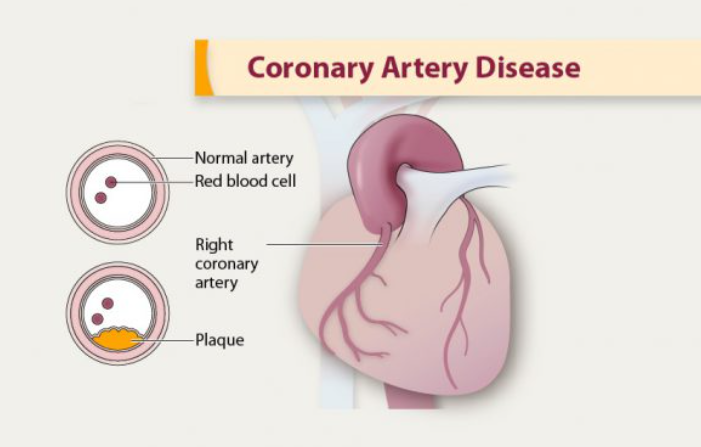Coronary artery disease, a common and potentially deadly health problem, doesn’t always show many symptoms, but you can reduce your risk.
Coronary artery disease is a major problem among Americans, affecting some 16.5 million adults, the Cleveland Clinic reports. The American Heart Association estimates that, on average, someone in the United States has a heart attack every 40 seconds, and this high prevalence can have deadly consequences. The Centers for Disease Control and Prevention report that “about 610,000 people die of heart disease in the United States every year—that’s 1 in every 4 deaths.”
Also read-Heart Failure : A Patient’s Guide To Congestive Heart Failure
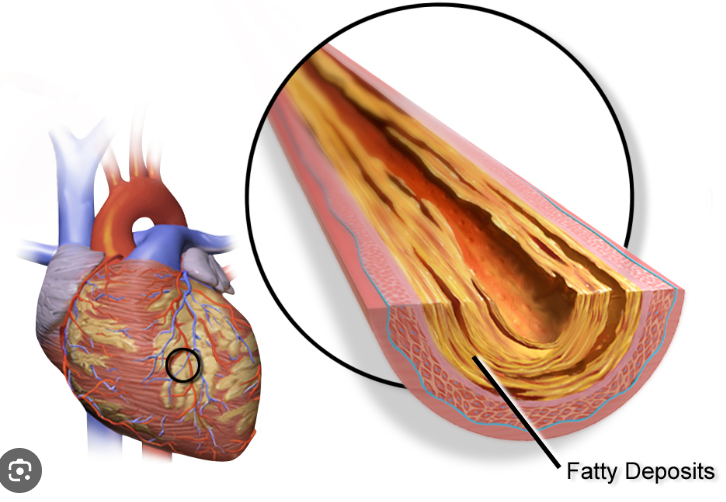
Coronary Artery Disease
The most prevalent type of heart disease among those total is coronary heart disease, which the CDC reports “kills over 370,000 people annually.” Often referred to as coronary artery disease, this widespread medical condition can cause major complications for a large number of individuals. The good news is that you can slow the progression of CAD and lower your risk of developing it in the first place by making lifestyle changes. Heart attacks, strokes, and death are just a few of the potential risks associated with CAD.
What is coronary artery disease?
Coronary artery disease, which affects the blood vessels surrounding the heart, is “the leading cause of cardiovascular death in the United States,” according to Montana’s Kalispell Regional Medical Center interventional cardiologist Dr. Mayank Agrawal. “Buildup of lipid-rich plaque in the walls of vessels supplying blood to the heart muscles” is the cause of coronary artery disease (CAD). Over time, the deposits of plaque that adhere to the inner walls of blood vessels may thicken to the point where they obstruct or completely stop blood flow.
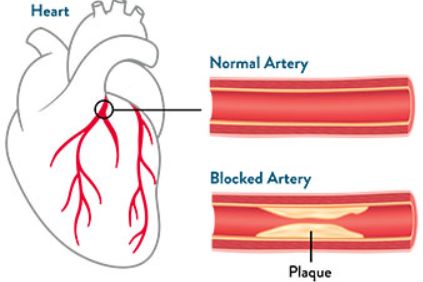
Coronary Artery Disease
This dense accumulation of fats, including cholesterol, in the blood can harden and crack. For this reason, CAD is also sometimes called “hardening of the arteries,” according to interventional cardiologist Dr. Brian Kolski of St. Joseph Hospital in Orange, California. This illness, which is also referred to as ischemic heart disease or atherosclerosis, may not have many symptoms at first but can have detrimental effects on health.
Symptoms of coronary artery disease
“When your heart muscle doesn’t get enough blood, you may have chest pain or discomfort, called angina,” the CDC reports. Angina is the most common symptom of CAD and may include feelings of pressure or tightness in the middle or left side of the chest that worsen with exertion but may go away when you slow down or stop. Angina may also feature a sharp or stabbing pain in the neck, arm, or back. Shortness of breath, especially upon exertion that’s out of proportion with the effort being expended, can also be a sign of problems.
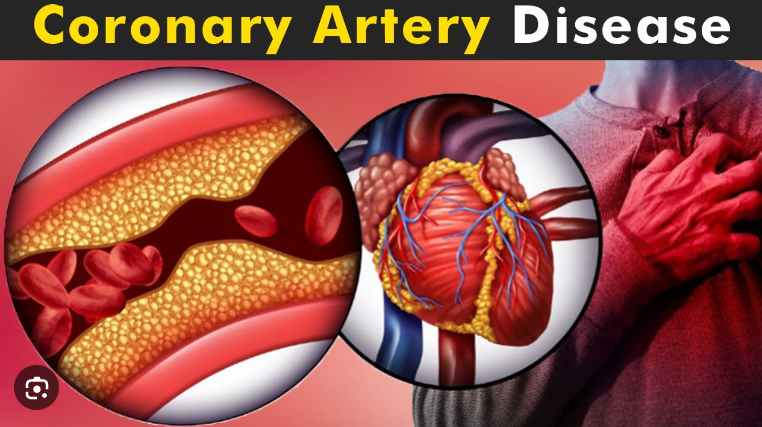
Coronary Artery Disease
One of the challenges with CAD is that it doesn’t always have clear signs or symptoms in the early stages, and symptoms may only show up when patients develop a complication. “For some people, the first sign of CAD is a heart attack,” the CDC reports.
Diagnosis of coronary artery disease
You’ll probably go through a series of tests to confirm any suspicions your doctor has about your possible diagnosis of CAD, including:
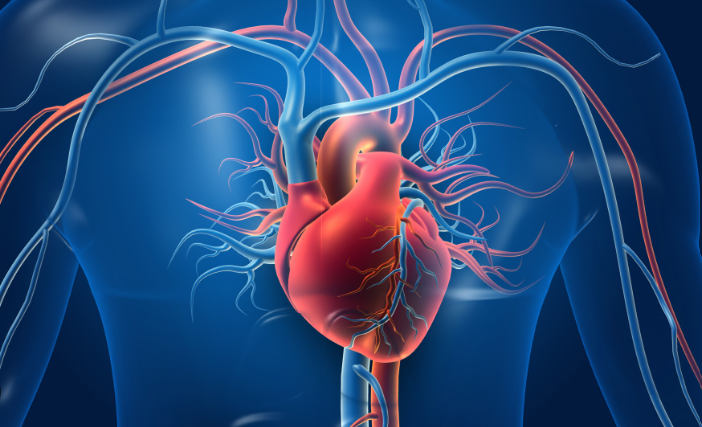
- Chest X-ray. A simple X-ray of the chest can give your doctor a view of your heart, lungs, and other organs in the chest to see if there are areas of damage or blockage.
- ECD or EKG. Also called an electrocardiogram, this test measures the electrical activity in the heart, your heart rate, and the regularity of your heartbeat.
- Echocardiogram. This ultrasound test uses soundwaves to create a picture of the heart that may show areas of damage or concern.
- Exercise stress test. During this test, you’ll be asked to walk on a treadmill while wearing various sensors so your doctor can see how your heart behaves when it’s asked to work harder.
- Cardiac catheterization. This procedure uses a thin, flexible tube inserted into arteries in and around the heart to measure blood pressure and blood flow and collect blood samples or to inject dyes into the arteries to show areas of damage.
- Coronary angiogram. Using the same tool as a cardiac catheterization, a coronary angiogram is used to monitor blood flow through the arteries after a dye that’s visible on an X-ray is injected into the artery.
Treatment of coronary artery disease
Your family doctor or a cardiologist should keep a close eye on your chronic condition, CAD. “Death from CAD has declined in most developed countries, mostly due to advances in care,” according to Kolski, despite the fact that CAD is still the leading cause of death in the United States. One of the most crucial parts of living with CAD is getting the right help as soon as possible.
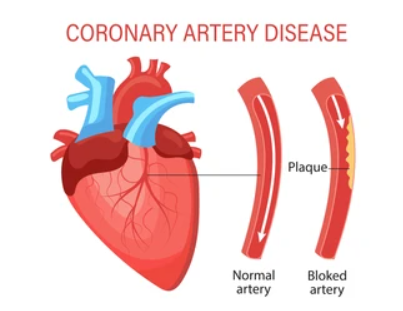
Coronary Artery Disease
Kolski asserts that “preventative approaches are the most important” strategy for treating the illness. This entails giving up smoking, decreasing body weight, and exercising consistently. “Medication is sometimes necessary for patients with high blood pressure and cholesterol.”
If you’ve developed symptoms of CAD, you may also be advised to undergo a procedure such as angioplasty, which is “used to treat heart attacks and angina,” Kolski says. During an angioplasty procedure, the doctor inserts a thin tube that’s tipped with a tiny, deflated balloon through a blood vessel in the arm or groin and threads it to the problematic site in the artery. Once the end of the tube is in place, the balloon is inflated, which pushes the plaque out of the center of the vessel. With the plaque moved aside, a freer flow of blood is restored. This can alleviate pressure and pain in the chest and may help reduce damage to the heart muscle after a heart attack.
In some patients, though, angioplasty isn’t enough, and these individuals may need to undergo a more intense surgical procedure, Kolski says. Particularly “in very advanced disease, coronary artery bypass surgery may be required.” In this procedure, the surgeon transplants a healthy blood vessel—typically harvested from the leg or arm—onto the heart to divert blood flow around the site of blockage or damage. It’s an intensive procedure that’s usually only used when other interventions have failed. However, it’s a common surgery that most patients recover well from.
Also read-Understanding Depression And Irritation: Causes And Solutions
images source: Google
Disclaimer: The opinions and suggestions expressed in this article are solely those of the individual analysts. These are not the opinions of HNN. For more, please consult with your doctor.







